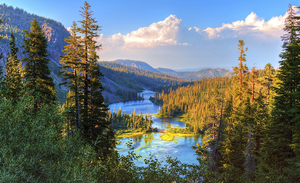Open ecological transition. Where is the Italian environment going?
A country covered almost 40% by forests, more than Germany and Switzerland, and which has seen protected areas of land and sea grow up to 20% of the national territory. Greenhouse gas emissions, which have decreased by 19% in the last 30 years, are reduced, as are the main sources of air pollution. However, ozone, the situation of large urban centers and the Po Valley are worrying. Progress also for the circular economy: the economy uses less and less natural resources, separate waste collection continues to increase and landfill is increasingly reduced. On the other hand, the situation for land consumption is worsening: 60 square kilometers still lost every year or 15 hectares a day.
ISPRA presented the Open Ecological Transition report on 13 December which allows us to interpret the changes that have occurred in recent years in the aspects of the Italian environment.
It is a clear synthesis of the many dynamics that determine the Italian ecological transition, which immediately brings the most important aspects of each problem or phenomenon to the attention of society, highlighting the critical issues but also the results already achieved or achievable.The document is divided into three parts: The Italian environment at a glance, Natural systems, Human systems, for a total of 12 chapters and 66 items.
- https://www.isprambiente.gov.it/en/archive/ispra-events/2021/12/open-ecological-transition-where-is-the-italian-environment-going
- Open ecological transition. Where is the Italian environment going?
- 2021-12-13T15:00:00+00:00
- 2021-12-13T16:30:00+00:00
- A country covered almost 40% by forests, more than Germany and Switzerland, and which has seen protected areas of land and sea grow up to 20% of the national territory. Greenhouse gas emissions, which have decreased by 19% in the last 30 years, are reduced, as are the main sources of air pollution. However, ozone, the situation of large urban centers and the Po Valley are worrying. Progress also for the circular economy: the economy uses less and less natural resources, separate waste collection continues to increase and landfill is increasingly reduced. On the other hand, the situation for land consumption is worsening: 60 square kilometers still lost every year or 15 hectares a day. ISPRA presented the Open Ecological Transition report on 13 December which allows us to interpret the changes that have occurred in recent years in the aspects of the Italian environment. It is a clear synthesis of the many dynamics that determine the Italian ecological transition, which immediately brings the most important aspects of each problem or phenomenon to the attention of society, highlighting the critical issues but also the results already achieved or achievable.The document is divided into three parts: The Italian environment at a glance, Natural systems, Human systems, for a total of 12 chapters and 66 items. Press release (ita) Open ecological transition Video Photo gallery
- When Dec 13, 2021 from 03:00 PM to 04:30 PM (GMT+0 / UTC0)
- Where Roma, Sala della Regina Camera dei Deputati/diretta streaming sul portale ISPRA
-
Add event to calendar
iCal

